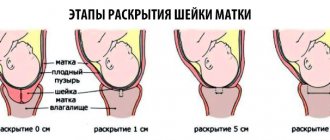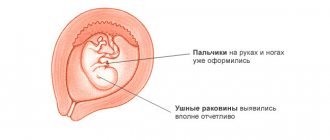- March 3, 2019
- Pregnancy
- Ekaterina Sobolevskaya
A normal birth that is ready to take place in a timely manner will never begin violently and suddenly. On the eve of this event, the expectant mother experiences their harbingers. The cervix begins to gradually prepare for an important process. All changes (water breaking, contractions starting) indicate that the baby will see the light very soon. How the uterus opens, what it actually is and what you need to be prepared for at this moment - in this article.
Stages of the birth process
Childbirth is the process of expulsion of the fetus and placenta from the uterus. If they take place in a standard manner, then everything happens naturally. In cases where doctors are forced to resort to different delivery methods using surgical intervention, childbirth is usually called operative. A woman needs to prepare in advance for what happens in the delivery room in order to be “armed” with knowledge. If she understands perfectly what will happen to her, how it will all happen, then giving birth will be easier.
Before you begin to understand how the cervix opens before childbirth, you need to know that childbirth consists of three stages. And each of them is very important for mother and baby. So these steps are as follows:
- dilation of the uterus (another name for it is dilation of the cervix);
- expulsion of the fetus;
- birth of placenta.
In terms of time period, the longest is the first period. It is then that, due to the fact that the uterus contracts, the amniotic sac forms, the baby passes through the birth canal. As a result, during childbirth, the cervix fully dilates and the baby is born.
Women giving birth for the first time experience this period for about twelve hours. For those who have had this not for the first time - a little less - about eight. Knowing exactly how many centimeters the dilation of the cervix will be during childbirth, you can accurately determine what phase of contractions is currently taking place.
Ways to ease contractions
If the pregnancy proceeds without complications and labor begins on time, then during the period of contractions a woman can use different techniques and positions to reduce her pain.
- Walking during contractions is a great way to make yourself more comfortable and also speed up the onset of the main stage of labor. When contractions are still rare, you can even go outside and take a walk near your home, and upon arrival at the maternity hospital, walk around the ward. It will be useful when walking from time to time to raise your legs bent at the knees high. This will improve blood flow in the lower abdomen. In an upright position, gravity helps labor, and the fetus descends into the pelvis faster.
- While contractions are rare, the cervix has not yet dilated, and the water has not broken, you can take a shower or a warm bath.
- In addition to the growing pain from contractions of the uterus, back pain is added, provoked by the weight of the fetus itself. To ease the condition during a contraction, you can:
- standing, lean your back against a support or rest your hands on the wall, on the back of a chair or bed;
- place your leg bent at the knee on a high support, for example, a chair, and lean on it;
- if a partner is present at the birth, you can use the “slow dance” pose: hug your partner by the neck, shoulders or waist, lean on it or even hang and sway, as if in a dance;
- squat down, leaning your back against a wall or chair; it will be convenient to place your back between the knees of your partner sitting on a chair;
- sit on a chair, the edge of the bed or a fitball, rest your hands on your spread knees and sway slightly;
- getting down on all fours - this not only brings relief, but also helps relieve the pressure of the fetus on large blood vessels; during intense contractions, a kneeling position with your chest resting on a bed or fitball helps;
- “baby pose” is a type of pose on all fours (legs spread wide apart, supported by elbows or arms extended forward); it is useful when the baby’s head is already pressing on the pelvic tissues, and the dilation of the cervix is still insufficient.
The cervix dilates
From about the thirty-second week of expecting a baby, the cervix begins to prepare for childbirth. And yet there is still a dense area of tissue near the cervical canal. And in other places, the cervix softens before childbirth. It all ends by the 38th week of expecting a baby. The future newborn has descended into the pelvis and with all its weight (although it may not be that big) puts some pressure on the cervix. This causes it to open up even more.
When the doctor tells a pregnant woman that she is one finger dilated, she begins to think about how long it will take to expect labor. But so far this situation only indicates that the body is physiologically prepared for childbirth. But they will begin when regular contractions appear. That is why dilation of only one finger will not tell you when labor will begin, but will indicate that the woman is ready to begin intensive labor.
Body readiness parameters
In addition to the fact that the opening of one finger has occurred and the neck has softened, it needs to be shortened - to a length of one centimeter. Now it is located in the center of the small pelvis, although some time ago it was deviated to the side.
During this period of pregnancy, there should be a discharge of the mucous plug, which protected the uterus during all the months of waiting for the baby. The fact that the plug has come away indicates that the cervix is ripe and contractions are about to begin. First, the internal os of the cervix opens, and when the fetus begins its journey through the birth canal, the external os also tends to stretch.
For those women who have already given birth before, this opening occurs simultaneously, so everything will take much less time than for those who give birth for the first time.
It is much more common for doctors to hear how many fingers should be dilated during childbirth, because they determine this based on their own fingers.
In some cases, it happens that labor has already begun, but the cervix is not at all ready and is not yet dilating. In this case, doctors may use stimulation because the fetus will not have enough oxygen due to the rapid aging of the placenta and its loss of ability to perform its basic functions.
Let's dwell on the terminology
How does the cervix dilate before childbirth? This process takes place without any symptoms. It can only be determined by a doctor when he performs a vaginal examination. In order to understand how far the process of softening, shortening and smoothing of the cervix is progressing, it is necessary to define obstetric terms.
Doctors often still today determine the opening of the uterine pharynx in the fingers (this was already mentioned just above). In other words, the number of fingers the pharynx can allow through is the same as its opening. The approximate width of the “obstetric finger” is two centimeters. But it is clear that everyone’s fingers are different, so it is considered most accurate when the opening is measured in centimeters, for example, the dilation of the cervix by 2 fingers.
Thus, if the cervix is dilated by one finger, then we are talking about an opening of 2-3 cm; if the opening of the pharynx has reached 3-4 cm, then it is said differently that the opening is two fingers. This is usually diagnosed when regular labor begins (at least three contractions in 10 minutes); Almost complete opening is indicated by the dilatation of the cervix by eight centimeters - or 4 fingers.
The doctor records full dilatation when the cervix is completely smoothed (its edges are thin) and there is patency of 10 cm - or 5 fingers (the head has dropped to the pelvic floor, turned into a straight size with an arrow-shaped suture, the woman has an irresistible desire to push - now it’s time to the delivery room in order for the long-awaited little one to be born - this is the beginning of the second stage of labor).
Poses before childbirth
At a time when contractions are actively underway, women are ready to do anything to make themselves feel better and speed up the process of delivery. Some prefer to be active, moving from one corner to another, while others, on the contrary, slow down their usual pace and try not to make sudden movements. Be that as it may, every woman has an individual approach to her body. However, not all pregnant women manage to find a “common language” with him. That’s why it’s so important to listen to the opinions of experts and experienced mothers before the baby is born.
Childbirth positions to open the cervix
As a rule, during contractions, most women prefer to remain upright. And rightly so, they do. After all, standing on their feet, they speed up the process of dilation of the cervix. If you also choose the right position in an upright position, you can significantly alleviate your suffering.
Movement is the best assistant during contractions
By constantly making movements during contractions, a woman in labor not only has a beneficial effect on the process of dilation of the cervix and the intrauterine state of the fetus, but also facilitates her own well-being. While in an upright position, you can rotate your pelvis, dance, step from foot to foot, squat slightly, or simply walk along the corridor of the maternity ward.
Using a support
At the moment when the contractions intensify, postures in which the torso is tilted forward significantly help to ease the well-being. So, a woman in labor can simply find support for herself in the form of a window sill, table or chair and lean on it. The “cat” position also helps to significantly reduce pain. To do this, you should kneel down, lean on your elbows and arch your back. Thus, the woman in labor will be able to relieve the load from the lumbar region. As a result, the woman will be able to significantly relax and rest between contractions. It is worth noting that the head in this position should be located below the pelvis.
Lying on your side
The “side lying” position is excellent for women in labor who have a breech presentation of the fetus and for those who, for some individual reason, cannot be in an upright position. In this position, you can not only ease contractions, but also take care of improving the blood supply to the fetus. In the “lying down” position, there is no process of squeezing the blood vessels, which affect the baby’s life. In addition, the movement of the fetus along the birth canal is more smooth and painless. The “side lying” position prevents prolapse of the umbilical cord loops, arms and legs of the fetus, which can occur as a result of spontaneous rupture of amniotic fluid.
Using a fitball
Today, many prenatal rooms are equipped with special furniture that is comfortable for women in labor. Almost each of them has a large inflatable gymnastic ball - a fitball. Using this attribute, a pregnant woman significantly relieves the load on the spine. In addition, rotational movements of the pelvis while sitting on a fitball are a natural, non-drug pain reliever for contractions. However, it is worth noting that you should become familiar with the benefits of a gymnastic ball during pregnancy. After all, during labor, women lose the desire to experiment with something new. However, the fitball has several variations in its use.

A significant relief effect comes from the position of sitting on a fitball with your knees wide apart to the side. Distracts from signs of uterine contraction and rotating movements of the pelvis, light bouncing, rolling. All these actions block muscle tension and prepare the birth canal for the movement of the fetus through it. In addition, during various movements on the ball, blood supply improves, which is the key to a favorable course of labor.
To gain strength before the next contraction, you can kneel down and lean your head and chest on a fitball. Thus, the load on the lumbar region is reduced, which makes it possible to rest a little.
Please note that for positions before childbirth, the gymnastic ball should be soft, not fully inflated. Only elasticity will allow you to be in a safe sitting position on it, without creating excessive pressure on both the uterus and the fetus.
What happens to the cervix before childbirth?
The doctor is required to examine the cervix before childbirth. This is done in the last weeks, when the expectant mother comes to the consultation each time. During all months of pregnancy, the cervix is long and hard, and the cervical canal is closed quite tightly - additional closure is carried out by a mucus plug. In the last weeks of expecting a baby, such an immature cervix is not the norm.
Its gradual changes begin approximately half a month before the due date. The neck gradually becomes more elastic and softer, its length is approximately halved. The opening of the uterus and softening of the cervix occurs in parallel with the release of the mucus plug, mucous discharge from the genital tract and contractions, which become harbingers. Little by little, the cervix turns forward due to the softening of the lower segment of the uterus. Now nothing can stop the baby from being born. When labor begins, the mature cervix will open with ease, its edges have now become elastic enough for the baby to appear successfully in this world.
Who may be included in the risk group?
The readiness of the cervix is very important if the expectant mother has factors that can lead to pathology during childbirth. A fairly serious attitude is required if:
- the onset of previous labor was also with an immature cervix and with labor disturbances;
- during a previous pregnancy, there was a late delivery date or the current pregnancy is post-term;
- there was erosion, during which the cervix was cauterized, or other operations were performed in the cervical area: now there is a risk of scarring;
- the date of birth needs to be brought forward due to the health status of the expectant mother or fetus;
- the pregnant woman has already begun labor, but the cervix is not yet prepared;
- During previous births, the woman had a Caesarean section.
In any of these cases, doctors decide on medical intervention in the birth process. Quite often - to save both the baby and the mother.
How to remember
Remembering pictures of birth positions from the Internet during childbirth is not an easy task. Reinforce theory with practice. Try each pose during pregnancy, breathe in it with diaphragmatic breathing. If you practice every day, gradually memorize all the variations of birth positions. During childbirth you will not have to consciously remember anything - all movements will be intuitive. The position you like during training will not always be comfortable during childbirth. We conducted a survey of women who studied at the Vasilisa School of Parents. 10 out of 15 responded that during childbirth they preferred a different position than the one they had chosen in advance.
Read more Why do your periods come at different times?
Anna: “During pregnancy, I liked the asymmetrical position on all fours. And during childbirth it turned out to be more comfortable to lie on your side and stand leaning on the headboard.”
The secret is simple: to remember all the poses, train and repeat them all. To help, we offer a complex of osteopathic gymnastics for pregnant women. It consists of birthing positions and movements that help the body adjust to childbirth. Every day, 10 minutes of gymnastics and all birth positions will become familiar and easy for you. During childbirth, you will be able to intuitively choose the most suitable and effective ones.
Diagnosis: immature cervix
Doctors use a similar term when labor is about to begin, but the cervix is still long and hard, the cervical canal is still closed, the cervix is wrapped as before and has not yet turned along the wire axis of the pregnant woman’s pelvis.
All this is a huge obstacle during childbirth. Stimulating the birth process if the uterus is immature is completely useless: the contractions needed at the moment will still not happen, the pregnant woman will begin to suffer, and labor will last more than a day. And yet, it’s unlikely that everything will work out on its own, without medical help.
It will also be quite difficult for the little one: he will not have enough oxygen, and besides, he may get injured, as well as his mother. Nature has invented the structure of a woman’s body - even if the cervix is not yet properly opened, the uterus will continue its contractions until the cervix or uterine wall ruptures during childbirth. The baby strives to be born, and it will be born, one way or another.
Necessary measures
Preparing the cervix for childbirth is truly a necessity. Especially if the expectant mother is overdue. How to prepare the cervix for childbirth? There are methods by which this can be done - medical and folk. Indeed, there are various folk methods that describe methods of preparation at home without the use of drugs. But you should not use at least one of the options without consulting a doctor in advance, because most of them are dangerous and can harm the baby.
If the cervix is not ready for childbirth
In cases where the dilatation of the cervix is delayed, there is a need to stimulate labor.
Use of clotrimazole during pregnancy
Intervention in the birth process is carried out according to certain indications:
- post-term pregnancy;
- prolonged labor;
- ineffective contractions;
- large fruit;
- unopened amniotic sac;
- pharynx rigidity.
To prevent weakness of labor, careful monitoring of the condition of the woman in labor and the fetus is necessary.
If the reason for the weakening of contractions is the whole amniotic sac, the membranes are opened. In each case, the doctor individually decides how to prepare the cervix for childbirth.
Often, especially in primigravidas and in women with previous cervical injuries, the pharynx becomes rigid. With this pathology, the process of opening is inhibited, which slows down the progress of labor. Contractions become frequent and painful.
Using a Foley balloon catheter to dilate the cervix
If there is rigidity, digital dilatation of the pharynx is used, and if the waters have broken, a Foley balloon catheter can be inserted. Your healthcare provider knows how to use a Foley catheter to dilate the cervix correctly.
The cylinder is a medical device that is intended for repeated use. The material from which it is made does not cause irritation or discomfort to the patient. Due to the fact that it can be subjected to heat treatment, the risk of the spread of bacterial flora in the body is reduced. The surface of the balloon is smooth, designed for painless insertion.
Foley catheter dimensions.
Most often, a two-way female catheter number 18 is used to induce labor.
Self-insertion of a catheter is contraindicated. Only a physician should insert a Foley balloon.
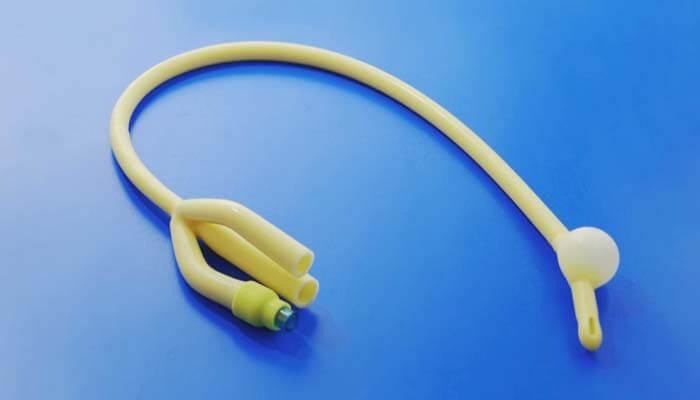
Foley catheter
Cervical dilation gel
To gently open the cervix, it is recommended to use substances that soften and make the cervical canal more elastic. Prostaglandins are used in the form of suppositories or gels. The drugs are harmless to the fetus and easy to use, greatly facilitating the dilatation of the cervix during childbirth. .
There are contraindications to the use of prostaglandins:
- history of caesarean section;
- incorrect position of the fetus (transverse, gluteal, oblique);
- clinically narrow pelvis;
- diabetes mellitus in a pregnant woman;
- threat of uterine rupture.
Taking into account the condition of the pregnant woman, the doctor chooses a method for preparing the cervix.
To ensure a successful outcome of childbirth, gymnastics is recommended during pregnancy.
Physical exercises to prepare for childbirth
Gymnastics during pregnancy includes exercises related to:
- with strengthening the pelvic floor muscles;
- preparing the pelvic bones;
- stretching of the muscles of the femoral part of the lower extremities.
In order to stimulate labor, gymnastic exercises associated with physical activity are recommended.
- Walking is an excellent method. During movement, the fetus gradually descends into the pelvic cavity and automatically the fetal head presses on the lower segment of the uterus. The cervix begins to stretch and open. A woman’s body begins to produce oxytocin, which promotes the onset of labor.
- Swimming helps relieve muscle tension, improves blood circulation, and relieves swelling. The pregnant woman’s nerves calm down and the fear that the woman experiences on the eve of childbirth goes away.
- Squatting is a simple exercise that helps the fetus take the correct position.
- Rocking is a preventive exercise before childbirth. You can swing at home on a ball or on a swing while sitting on the sofa.
It is better to start doing gymnastics in advance, memorizing the exercises and repeating them periodically. This will make childbirth easier for both the woman and the baby.
If there are no contraindications, home stimulation methods are used.
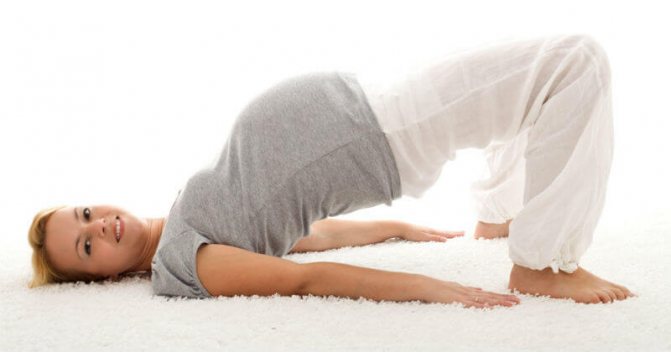
Gymnastics at home
Self-induction of labor
A proven method for preventing labor weakness is nipple massage. Irritating the nipples with your hands promotes the production of oxytocin, the main hormone that “triggers” the labor mechanism. The main thing is not to overdo it, so as not to cause cracks. After the massage, the nipples are lubricated with an antiseptic, for example an oil solution of chlorophyllipt.
Cervix in early pregnancy
At home, it is acceptable to use an enema filled with cool water. By stimulating the work of the intestines, the smooth muscles of both the intestines and the uterus begin to contract, which leads to an acceleration of the onset of labor.
It is known that sex is a natural method of stimulation. This method replaces in total: walking, swimming and massage. The only contraindication for intimacy is the threat of premature birth.
The reasons for cervical incompetence are different; in any case, the task of the pregnant woman and her doctor is to carry the pregnancy to term until the fetus matures.
Medical methods. Laminaria and chairside examination
In order for the cervix to ripen as quickly as possible and the uterus to open, the gynecologist introduces kelp into its canal - thin (thick as a match) sticks that can expand tens of times when exposed to moisture. They are made from seaweed. They are administered to the expectant mother on a gynecological chair. The procedure itself is quite unpleasant and can cause pain, but the next couple of days will be even more interesting. Laminaria, increasing in volume, will constantly exert increasing pressure on the neck, swelling in its canal. And the cervix, in turn, will quickly soften and ripen, which will be accompanied by training contractions, pain in the lower abdomen and mucous discharge.
The dilatation of the cervix will accelerate when the woman is examined by a gynecologist on the chair. You can hear from some mothers that after this procedure, when the patency of the cervical canal is checked, their mucous plug comes off and the process of preparing for childbirth is accelerated.
What positions are best after childbirth?
During pregnancy, many women simply dream of lying on their stomachs. But they are given such an opportunity only after childbirth, when such a body position is already a necessity.
Unlimited lying on your stomach is recommended by specialists after childbirth to speed up uterine contractions and the release of lochia (postpartum discharge). However, not everyone can be in this position 2-3 days after the end of labor. The thing is that during this period of time the mother’s milk begins to come in. During hot flashes, the comfort of lying on your stomach decreases sharply. In addition, squeezing the breasts can result in lactostasis for a woman. Therefore, if painful sensations appear in the mammary glands, it is better to change the position recommended by experts to a more comfortable one for the mother.
If contractions and attempts pass without complications, the woman in labor herself has the right to choose the most correct position for childbirth. Otherwise, pregnant women are advised to listen to the opinions of specialists. Only a professional can monitor labor activity and argue for optimal positions at one time or another. It is also worth emphasizing that sitting at a dilation of 4-5 cm on a hard surface is strictly prohibited.

The birth of a new life is like a miracle. However, childbirth is 15–20 hours of hard work. Help your body cope with the work by using birth positions and movements.
Birth positions are body positions in which a woman in labor feels most comfortable and comfortable. They are natural for a woman giving birth and help relieve pain from contractions, maintain strength and move the baby towards the exit of the pelvis.
The article talks about birth positions for resting and waiting out contractions and vertical birth positions suitable for contractions and pushing. Videos and drawings will help you understand how to move in each of the birth positions. Let's also talk about how to remember these movements in your own childbirth, and how to use them in the maternity hospital.
Birth positions. Fragment of the video tutorial “Preparing for natural childbirth”
Birth positions are similar among women of different nationalities and cultures. No one can tell you in advance what position you will feel good in. Try each position during pregnancy, try it on yourself, breathe. And during childbirth, listen to your body, it will tell you.
“A woman, sheltered from danger and prying eyes, often prefers to give birth in positions characteristic of mammals, for example, on all fours.”
M. Oden, obstetrician, author of books on natural childbirth
Read more Mantu size for a 5 year old child
We recommend combining birth positions with diaphragmatic breathing. This is when when you inhale, your stomach expands, not your chest. According to osteopathic doctors, healthy people breathe like this from birth. During childbirth, this type of breathing helps open the cervix, expands the birth canal and relieves pain.
Methods of medicine. Antispasmodics and prostaglandins
Before the birth process begins, a hard cervix can soften if the doctor uses antispasmodics and beta-blockers. But medical workers use treatment with tablets and injections much less often.
A quick, albeit painful, discovery also occurs after using a gel that contains prostaglandins. It should be inserted into the cervical canal, which will quickly soften. In this case, training contractions and precursors intensify - the pregnant woman quickly gets tired.
Folk methods. Good old sex
How to prepare the cervix for childbirth without using any medications?
Having sex before giving birth will help dilate your cervix. Moreover, both due to mechanical stimulation and due to the fact that male sperm contains a large amount of prostaglandins. By the way, orgasm itself, when a woman is fully ready, can provoke labor.
Another option is to increase physical activity. A woman can walk up the stairs, clean the house while squatting, and the like. This method will not work if there is a pregnancy pathology.
The ripening of grass necks will help - rose hips, hawthorn, raspberry and strawberry leaves, evening primrose oil. And here there are some restrictions: the expectant mother may have an allergy or intolerance to herbs, unexpected reactions of the body. Therefore, first of all, you need to consult a gynecologist and under no circumstances self-medicate.
Unpleasant “surprise” after childbirth
A similar disease as cervical erosion after childbirth occurs in those women whose birth of a long-awaited baby was accompanied by complications. If the cervix is very difficult to open during childbirth, this will greatly increase the risk of internal tissue rupture. If the doctor did not notice them in time or applied the sutures carelessly, erosion will almost always occur in this case.
What is cervical erosion after childbirth? The cervix is an extension of the uterus itself, a kind of “canal” that connects the uterine cavity and the vagina. During examination, the gynecologist can see only its vaginal part (exocervix), but the internal part (endocervix or cervical canal) is not available for examination. When the endocervix becomes visible, the doctor says that the patient has cervical erosion.
The provocateurs of the disease are: frequent abortions in the past, early or late births, rapid or rapid labor, significant fetal size. Various infectious diseases that can be transmitted through unprotected sexual contact can also lead to the disease.
Childbirth positions
When labor is already in the penultimate phase - the onset of pushing, the pregnant woman needs special composure and, possibly, the support of her partner. There are several positions that help expand the birth canal and reduce labor time. When asking the question: “Which postures during childbirth are correct?”, one cannot get a definite answer.
If we consider the situation from the point of view of comfort for the pregnant woman, then the most correct position during childbirth will be the one that will provide the most comfortable conditions for her. However, not all experts support positions that make the work of health workers more difficult. Therefore, they prefer that pregnant women remain on a bed or in a chair during childbirth. However, modern delivery rooms are equipped with furniture and elements that make labor easier.
In the provided pictures of birthing positions, you can see various variations of body positions, both during contractions and pushing.
Read more Pelvic floor muscle training at home
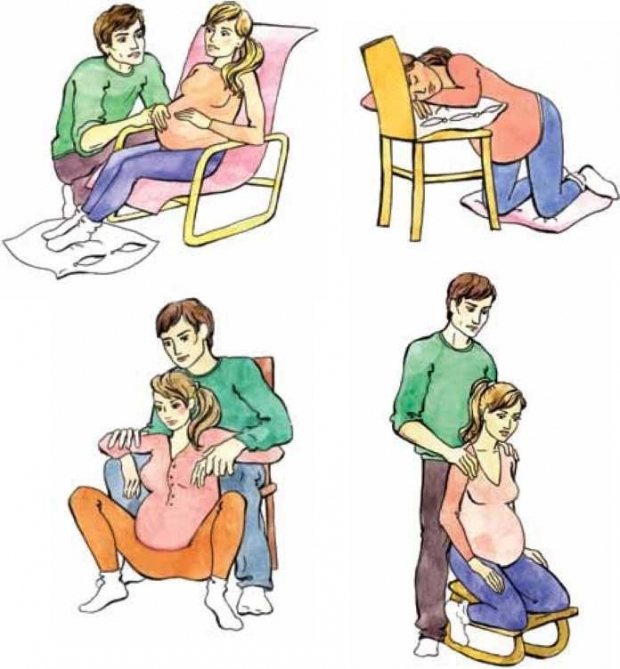
Lying on your back
Even in the last century, all women in labor welcomed their baby while lying on their back. However, this comfortable position for childbirth today is outdated, as it creates discomfort for mother and baby. The thing is that in this position the blood vessels are compressed, as a result of which blood circulation in the placenta is disrupted. For this reason, the mother experiences dizziness. In addition, the process of contraction of the uterus and dilatation of the cervix slows down. This position is among the most painful and complicates the correct insertion of the baby’s head into the birth canal.
However, in practice, there are also situations when it is not possible to carry out the last stage of labor except lying on your back: – in case of prematurity of the fetus; – delayed intrauterine development of the baby; – during rapid labor; – if the baby is in a breech position. Experts also recommend this position to pregnant women who want to relieve pain from contractions with epidural anesthesia. In this case, only in the supine position does the drug spread evenly over the lumbar region.
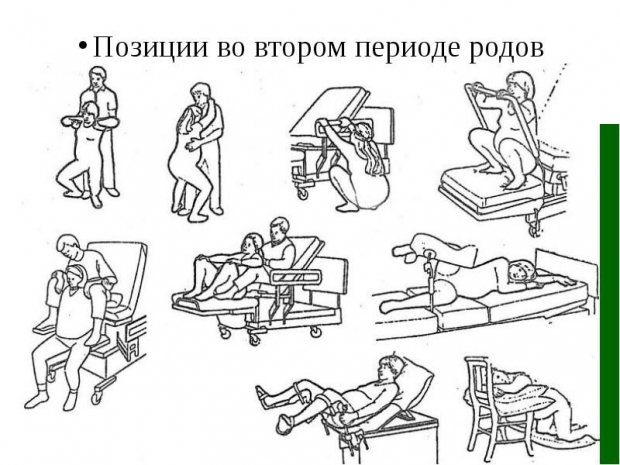
Reclining
In modern maternity rooms, special chairs are provided for the “reclining” position. In this case, a point located slightly above the tailbone serves as a support for the entire body. In this case, the torso is located at an angle of 450C, and the legs, under which it is advisable to place pillows, are spread apart. The limbs bent at the knees, with the feet brought as close as possible to the buttocks, also significantly contribute to the expansion of the perineum.
Squatting
Pushing while squatting is one of the best positions for childbirth. This position does not require special efforts from the pregnant woman; the baby practically comes out on his own. However, this position requires special physical preparation or support from a partner.
The woman needs to squat down and spread her knees wide to the sides. At the same time, in order to avoid the rapid birth of the baby, the body should be pushed forward and the head should be lowered down. When the baby's head appears, you need to stand up and straighten your knees. At the same time, a woman may rest against something.

